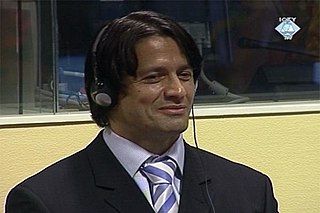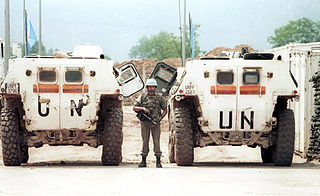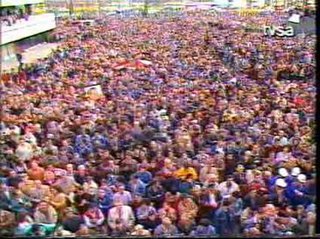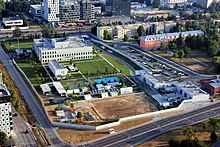
The Siege of Sarajevo was a prolonged blockade of Sarajevo, the capital of Bosnia and Herzegovina, during the Bosnian War. After it was initially besieged by the forces of the Yugoslav People's Army, the city was then besieged by the Army of Republika Srpska. Lasting from 5 April 1992 to 29 February 1996, it was three times longer than the Battle of Stalingrad, more than a year longer than the siege of Leningrad, and was the longest siege of a capital city in the history of modern warfare.

Naser Orić is a former Bosnian military officer who commanded Army of the Republic of Bosnia and Herzegovina (ARBiH) forces in the Srebrenica enclave in eastern Bosnia surrounded by Bosnian Serb forces, during the Bosnian War.
The 1992 Yugoslav People's Army column incident in Sarajevo occurred on 3 May 1992 in Dobrovoljačka Street, Sarajevo, when members of the Bosnian army (ARBiH) attacked a convoy of the Yugoslav army (JNA) troops that were exiting the city of Sarajevo according to the withdrawal agreement.
The 1992 Yugoslav People's Army column incident in Tuzla, also known as Tuzla column was an attack on the 92nd Motorized Brigade of the Yugoslav People's Army (JNA) in the Bosnian city of Tuzla on 15 May 1992. The incident occurred at the road junction of Brčanska Malta. At least 54 soldiers of the JNA were killed and 44 wounded during the attacks. What started off as a peaceful retreat by agreement with local authorities ended in an ambush, when Patriotic League, Green Berets and Bosniaks from local police attacked the column. It was a repeat of a similar incident that occurred in Sarajevo a week prior.

Radovan Karadžić is a Bosnian Serb politician who was convicted of genocide, crimes against humanity and war crimes by the International Criminal Tribunal for the former Yugoslavia (ICTY). He was the president of Republika Srpska during the Bosnian War.

The siege of Srebrenica was a three-year siege of the town of Srebrenica in eastern Bosnia and Herzegovina which lasted from April 1992 to July 1995 during the Bosnian War. Initially assaulted by the Yugoslav People's Army (JNA) and the Serbian Volunteer Guard (SDG), the town was encircled by the Army of Republika Srpska (VRS) in May 1992, starting a brutal siege which was to last for the majority of the Bosnian War. In June 1995, the commander of the Army of the Republic of Bosnia and Herzegovina (ARBiH) in the enclave, Naser Orić, left Srebrenica and fled to the town of Tuzla. He was subsequently replaced by his deputy, Major Ramiz Bećirović.
Ramiz Delalić, widely known by his nickname Ćelo, was a Bosnian organized crime figure and warlord, commander of the 9th Mountain Brigade in Sarajevo. He was one of several prominent underworld figures engaged by the Party of Democratic Action in preparations for the war in Bosnia and Herzegovina. Delalić gained notoriety as the main suspect who stood trial before a local court for the killing of Nikola Gardović on 1 March 1992.

Ratko Mladić is a Bosnian Serb former military officer and convicted war criminal who led the Army of Republika Srpska (VRS) during the Yugoslav Wars. In 2017, he was found guilty of committing war crimes, crimes against humanity, and genocide by the International Criminal Tribunal for the former Yugoslavia (ICTY).

The United States Department of State opened the United States Embassy in Sarajevo, Bosnia and Herzegovina, on July 4, 1994. Bosnia and Herzegovina had formerly been a part of Yugoslavia; the United States recognized the independence of Bosnia and Herzegovina on April 7, 1992.
Donja Bočinja is a village in the municipality of Maglaj in Zenica-Doboj Canton, Federation of Bosnia and Herzegovina, Bosnia and Herzegovina.
Gornja Maoča is a village in northeastern Bosnia that territorially belongs to the Srebrenik municipality, Tuzla Canton in the Federation of Bosnia and Herzegovina. It is in the Majevic mountain range, located directly south from the village of Maoča. The name of the village can be translated as "Upper Maoča".

The Battle of Vrbanja Bridge was an armed confrontation which took place on 27 May 1995, between United Nations (UN) peacekeepers from the French Army and elements of the Bosnian Serb Army of Republika Srpska (VRS). The fighting occurred at the Vrbanja Bridge crossing of the Miljacka river in Sarajevo, Bosnia and Herzegovina, during the Bosnian War. The VRS seized the French-manned United Nations Protection Force (UNPROFOR) observation posts on both ends of the bridge, taking hostage 12 French peacekeepers. Ten were taken away, and two were kept at the bridge as human shields.
Events in the year 2015 in Bosnia and Herzegovina.

On 5 April 1992, in response to events all over Bosnia and Herzegovina 100,000 people of all nationalities turned out for a peace rally in Sarajevo. Serb Democratic Party (SDS) snipers in the Holiday Inn in the heart of Sarajevo opened fire on the crowd, killing six people and wounding several more. Suada Dilberović and an ethnic Croat woman Olga Sučić were in the first rows, protesting on the Vrbanja bridge at the time. The bridge on which Sučić and Dilberović were killed was later renamed in their honor. Six SDS snipers were arrested, but were exchanged when the SDS threatened to kill the commander of the Bosnian police academy who had been captured the previous day, after the Serb paramilitaries took over the academy and arrested him.
The 2015 Zvornik police station shooting happened on April 27, 2015 when a gunman attacked a police station in Zvornik in the Republika Srpska entity of Bosnia and Herzegovina. He killed a police officer and wounded two others before being shot dead by other police officers. This was the first attack of its kind in Republika Srpska; attacks have occurred in the other entity, the Federation of Bosnia and Herzegovina, including the 1997 Mostar car bombing.
There has been an increase in incidents involving alleged radical Islamism in the Balkans since the 1990s.
Around 2:30 p.m. on Sunday, 1 March 1992, a Bosnian Serb wedding procession in Sarajevo's old Muslim quarter of Baščaršija was attacked, resulting in the death of the father of the groom, Nikola Gardović, and the wounding of a Serbian Orthodox priest. The attack took place on the last day of a controversial referendum on Bosnia and Herzegovina's independence from Yugoslavia, in the early stages of the breakup of Yugoslavia and the Yugoslav Wars.

The siege of Goražde refers to engagements during the Bosnian War (1992–95) in and around the town of Goražde in eastern Bosnia.
Nusret Imamović is a Bosnian Islamist leader who founded the Salafist community in Gornja Maoča.









